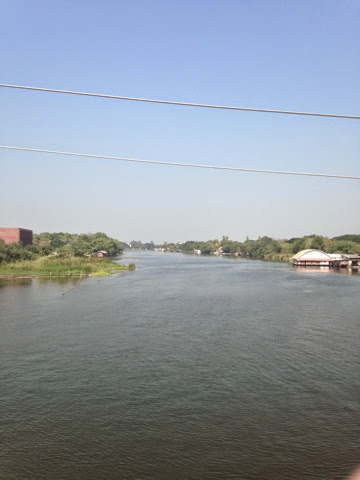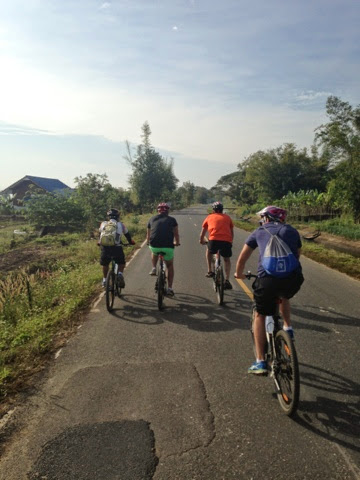After a grueling 2 hour drive from Chiang Mai to The Pong Duad Hot Spring, our group finally set off on the first leg of our trek. I was practicing mind over body: it was clear to me that I had bronchitis and fortunately, my roommate had some antibiotics that she was willing to share with me. But I was secretly very, very concerned. My small pack felt heavy and I found myself short of breath with even the smallest incline. As an asthmatic, I'm no stranger to bronchitis and the potential danger that it could represent for me. My greatest fear was that I would somehow impact the group. But it was too late to turn back and I plodded along, taking comfort on the fact that our first leg would only be 1.5 hours.
In fact, we came to the village of Ban Pong Noi, a small village of ten families of the Karen tribe in just over an hour. The first sign of civilization was a happy looking pig tied to a rudimentary hut. And then another. And then, a pathway, framed by large poinsettia trees opened to a much larger barn-like structure, which I learned would be our accommodations for the evening. We were all anxious to check out our digs,and after removing our shoes, we climbed the steep staircase to a large covered porch. Our digs turned out to be a large room with 9 mats, a pile of blankets, a pillow, and mosquito netting, a necessity for this region that featured malaria and dengue fever.
Sleeping in a loft in a barn-like building was apparently a novel experience for us all. And we happily set up our beds, reminded of our childhood days of fort building and the like, and smothered on our deet to protect from the Mosquitos, preparing ourselves for darkness to fall. I was glad that I had rented a sleeping bag, most had not. As I spread my brand new silk sheet inside, I felt pleased that I did not have to give too much thought to sanitation. I ended up next to a window, which was really a cut out diamond shape in the wall. I appreciated the extra light at that moment. Little could I have known that that window would provide me with an unending shower of moist cold air in the middle of the night.
After set up, I was anxious to check out the village. First, of course, was to check out the latrine. After taking in the sweeping view from the porch overlooking the village's recently harvested rice paddies, I spotted the facilities. To the left, a small hut featuring a cold shower for the not so feint of heart, to the right, a "bathroom" featuring a squatting toilet and a water spigot into a bucket. After using the toilet, we were to wash it down by pouring water into it. I did not learn where it all went. Based on the train experience, which I learned went straight on the tracks, I figured it would be much the same.
The village was lively. Chickens and chicks wandered about as did dogs and the occasional cat. I could hear children laughing, but generally, people remained out of sight. Each family had a home not too dissimilar from ours, which I learned had been built by our travel company, Intrepid, for the express purpose of hosting travelers like ourselves. Houses were built high up on stilts, which serves a number of practical purposes. Underneath, a family might be storing dried rice, a chicken coop, or even clothing. Kitchens, rooms that featured basic shelving and an open fire, had designated areas where washing occurred, the water and the waste dripping down to the ground below where the chickens and dogs rooted around for food scraps.
Our dinner was being prepared by Eddie, one of our guides with a terrific sense of fun, with the assistance of Rich. I was mesmerized by their process--fresh produce and meat were assembled neatly on trays on the floor. Eddie had rigged up some music from his iPod, and we all helped ourselves to warm cans of beer, provided at the rate of $2 each by the villagers. Before long, we were visited by a couple of ladies offering some wares for sale. Initially I felt somewhat obligated to make a few purchases, a couple of rope bracelets and a pair of earrings, but I realized pretty quickly that it was all machine made and really, really cheap. Later, when approached by villagers, I refused to buy any, which brought on hard stares and looks of disgust.
Dinner turned out to be spectacular. Eddie, as it turned out, has an incredible gift in the culinary arts. For both nights of our trek, Eddie turned out course after course of traditional Thai dishes, easily the best food that I had tasted since arriving in Thailand.
The cold fell fast and I was the first to turn in. While there was a small bonfire of sorts, and Eddie was getting out his guitar and "happy water", Rye whiskey with blackberries, I was anxious to stave off further illness so I opted out of the fun. I snuggled down in my sleeping bag keeping all my clothes on, including my jacket. The sleeping bag was clearly designed for a chilly evening, not the descending arctic blast that we were experiencing. The unseasonable cold was great for hiking, but rough for sleeping. And when I awakened in the middle of the night with a raging sore throat and freezing cold as wet cold air rained on my head, I cursed myself for not piling on the dirty blankets and leaving my wool scull cap at home. It was COLD. Sanitation be damned, I piled on anything and everything I could, all the while praying intensely that I would not awaken even sicker.
The next morning, all we could do was laugh and laugh. We all froze. And I was particularly thrilled to hear Luca, a 20-something tough guy from Australia, recount his own middle of the night reckoning with sanitation, as he introduced all the dirty blankets into his sleeping bag in an attempt (failed) to find a modicum of warmth. If nothing else, we had bonded as a group. Even the guides proclaimed the cold to be highly unusual.
Amazingly, I was able to hold my own while trekking the next full day. The terrain was varied enough that after each incline, I had an adequate amount of time to rest as we walked long distances on mountain ridges. We had our lunch at another small village along the way, the traveled on to a much larger village for another night in a sleeping loft.
This Karen village, Ban Pa Khao Lam, was perched above a wide river and despite the cool, I could hear young children playing in the river, swimming until near dusk. Bed set up went faster this time and we were ready for the cold. My strategy: 2 pairs of pants plus a borrowed hat. Also, we battened down the windows and doors, keeping the cold wet air at bay.
Before long, women appeared offering massages. I did not hesitate. For 200 baht, about $6, I received a delicious one hour full body massage. As the late
afternoon sun streamed into the barn and the sound of cow bells and children playing permeated the air, I could not imagine a more enjoyable setting. Later, after another even more delicious meal prepared by Eddie and Rich, some of us commented to one another that a 5 star hotel could not deliver a better experience.
Each day, Rich prepared us for what we could expect for the following day. I was clearly on the mend from bronchitis, but nowhere near free and clear. Rich warned us of a "big up." I was worried. The "ups" were downs for me. As it turned out, nothing could have prepared me for what was to come.
It was not until our third and final trekking day that the "big up" happened. The morning passed easily enough. We followed a river for a while and I enjoyed the changing flora and fauna. After stopping at Eddie's home village, where I stupidly consumed 2 small bags of Lay's potato chips, one flavored barbecue Thailand-style (I do not recommend), we started the incline. It was steep, very steep,and within 10-15 minutes, I was hacking and gasping. My lung capacity was still at about 60% of my norm and I felt queasy, no doubt worsened greatly by the disgusting chips. It did not take long for the group to start to pull ahead, and I fell woefully behind. I had to stop every 20 yards or so, if even that far, to catch my breath, and more than once fell completely on the ground. I kept asking Rick when the "big up" would be over. He was grim.
In the end, the group was held back about an hour or more due largely to my inability to keep pace. I took very small comfort in that my roommate also paced with me, but I was not sure if that was out of necessity or kindness. She is a doctor from Canada, and she instructed me on breathing techniques, which definitely helped. It was difficult to appreciate the gorgeous vistas and ever changing landscape. I had made it this far, but the prospect of dying on the mountain crossed my over imaginative mind more than once. My legs were fine. It was my lungs that betrayed me.
The guides cut the hike about 40 minutes short. Some members of the group were cranky about it and I felt terrible when I found out. But luckily, that all came much later. When I saw the group at the final meeting area, I was wild with enthusiasm. I had made it. The trek itself paled in comparison to my Inca Trail trek in terms of technical difficulty. But the bronchitis, way underestimated by me, turned that trek into Mount Everest as far as I was concerned. It was a tough lesson and one I'll never forget. We had trekked 20 miles through the mountains. Looking ahead, I had two days of over 70 miles of biking. I was prepared to stay behind, if necessary. Time would tell.























































